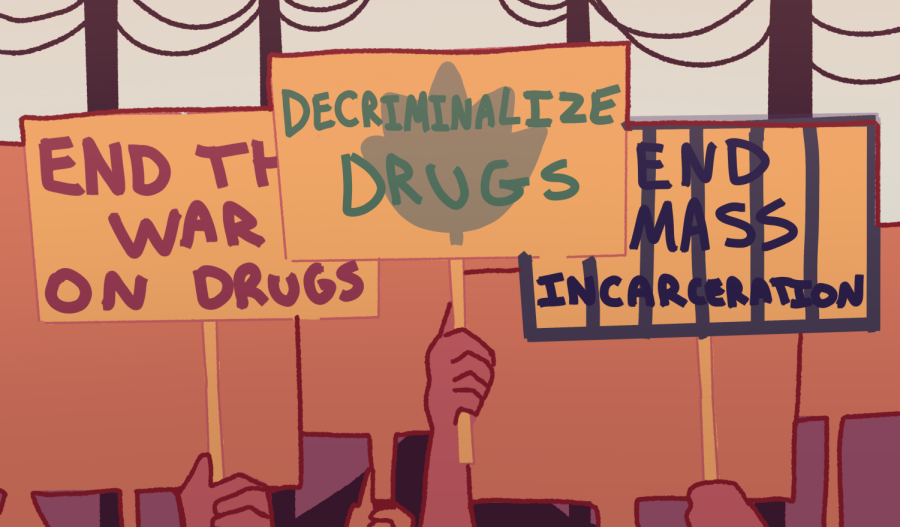Opinion | Let drug decriminalization win the War on Drugs
March 10, 2022
The CIA sold drugs in the 1980s. That is a bold statement and not entirely true, but it is what was picked up by most of the population when journalist Gary Webb reported on it. This, added with the fact that in 1971, President Richard Nixon declared drug abuse the public’s biggest enemy, and later President Ronald Reagan’s expansion on these policies, created an endless war on drugs.
Throughout this war, many things have happened and been tried, such as an opioid epidemic and the legalization of weed on the state government level. Despite the current legalization of weed, drugs should not be legalized. Instead, the United States should aim to decriminalize drugs so that there can be an end to this war.
The start of this war goes back to 1979, in the jungles of Central America, when the Nicaraguan dictatorship was overthrown by socialist revolutionaries called the Sandinistas. “In response to this, a right-wing group called the Contras began a brutal paramilitary campaign and received money and weapons from the CIA,” adds Vice Reporter Jamie Clifton. “However, in 1982, Democrats in Congress passed laws to cut off support for these Nicaraguan rebels.”
Subsequently, the Contras and the CIA had to find a new way to fund their struggles. They turned to cocaine. In the early ’80s, smokable cocaine and crack exploded across American cities. This created a goldmine for multiple groups, especially the CIA. In essence, the CIA had knowledge of this drug trafficking, allowed it to happen, funded it and even made money off it. Now, these drugs are found everywhere in our society, spurring rampant corruption and gang violence.
One way to try and help the issue is by legalizing drugs — something that most progressives endorse. They say it is a great form of harm reduction: A range of public health policies designed to lessen the negative social/physical consequences associated with human behaviors.
Get The Daily Illini in your inbox!
Moreover, legalization when it comes to drugs removes all penalties for possession and personal use of a drug. Legalization also includes regulations so that these drugs can be properly managed in terms of production and sale; penalties may apply if sales and production occur outside of this regulation.
However, the issue with legalization is that its biggest enemy is capitalism. This can be seen within the opioid epidemic.
The opioid epidemic began in the late 1990s with the 1996 birth of Purdue Pharma’s OxyContin. After this birth, the federal government pressured doctors to prescribe opioids through a campaign known as “Pain as the Vital Sign.” This campaign was as it sounds: It introduced the concept of pain seen as the fifth vital sign alongside the typical things doctors normally check during routines.
This campaign allowed drug companies to misleadingly market opioids as a treatment for chronic pain. Because of drug company lobbying, the government loosened access to opioids by requiring insurers to cover the drugs. Eventually, in 2014, the Drug Enforcement Administration rescheduled opioid painkillers to put harsher restrictions on them. In 2016, Congress finally passed a law that seriously addressed the epidemic.
The worst part was that this epidemic could have easily been prevented with better regulation. To stop this, for starters, the Food and Drug Administration could have blocked/restricted the use of opioids to better account for the risks and lack of scientific evidence that they are effective. The Drug Enforcement Agency could have limited the opioid supply and set production quotas for some opioids such as hydrocodone and oxycodone.
Instead, the DEA let these quotas rise and focused on illegal facilities that act as regular health clinics but would prescribe painkillers without going through the proper channels; These were called pit mills. This is just one example of bad government regulation and policies.
Another example of bad government regulation and policies can be seen in Switzerland’s Needle Park. In the late 1970s, there was an abundance of the use of heroin and cocaine in Zurich, and by 1980, one could see groups of 100-400 people using these drugs openly. The police tried to disperse this to no avail, as the users would just go somewhere else. Realizing the scope and gravity of the situation, the government wanted to help these people.
So, a public park behind Zurich’s main train station became a supervised zone for drug users in 1987. Platzspitz Park became a needle hotspot for heroin users as addicts and dealers came from across Europe to partake in this activity without being arrested until 1992, when authorities shut it down due to heavy political pressure. Up until its shutdown, Platzspitz had dealers, addicts and doctors all packed in the park selling, using and treating.
After the shutdown, the government did not give up and instead learned from its mistakes. The use of drugs without arrest does not mean a lack of regulations. Following this incident, in 1994, Switzerland adopted a four pillars policy: prevention, therapy, harm reduction and repression. This has proven quite effective as the number of drug consumption deaths and crime has decreased as well as 1,700 addicts having benefited since the policy’s implementation. On top of this, Switzerland barely sees new heroin users. This is a great example of how government regulation could make all the difference.
On the other side, there is the option of decriminalization left to explore.
Aditya is a junior in Business.







